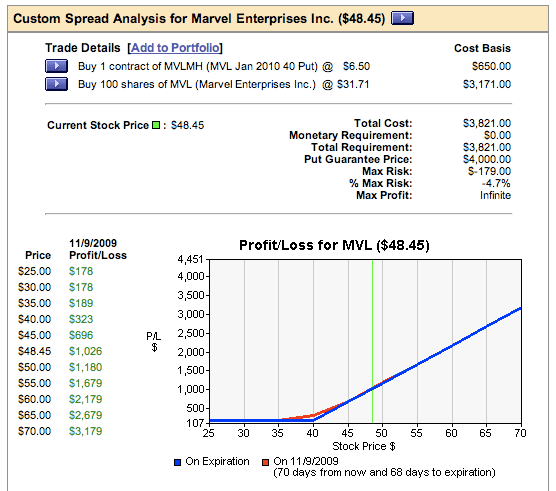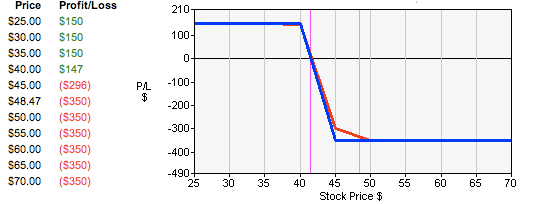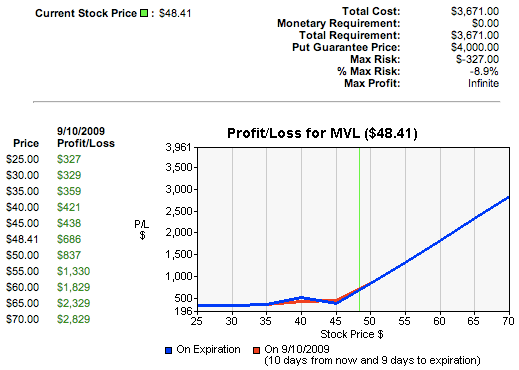IN the last installment of this blog, I mentioned that it was important to have more than one “arrow in your quiver” when it comes to playing the current market conditions.
I then went on to lambaste the strategy of selling covered calls… NOT that it’s necessarily a bad practice overall. It’s just that covered call selling is a trading strategy that’s only appropriate for one specific kind of market: sideways and choppy. In a market that’s trending up or down, covered calls are a losing proposition.
Unfortunately, there are so many gurus and groups out there that are “one-trick ponies”… claiming that covered call selling is the best strategy for ANY market. This way of thinking is not only incorrect, it’s DANGEROUS… as anyone that held unprotected stocks through the crash last year can testify.
So what’s the answer? Well, as I mentioned in my last blog entry: if covered calls only work in one specific kind of market, then it pays to know how to RECOGNIZE that kind of market and capitalize on the short-lived opportunity. But more importantly, we must learn the kinds of strategies that work best in other markets, because that’s what we’ll be dealing with most of the time.
Recently we’ve seen a trend UP. Selling “plain vanilla” covered calls during such a market only sorts the winners OUT of your account, while leaving the losers in. Not cool. On the other hand, my subscribers have been watching me do strategies much better suited to the market we’ve been in. Here’s the details on a trade that recently netted me 29.5% in about two months…
After closing a trade with MVL that had netted me a 4.1% return (during a period of time that the S&P only gained 0.5%), I had 100 shares left over at a cost basis of $31.71.
Since MVL was trading at $35.98 during that time, I had a choice: Either cash in the 100 shares for $4.27 profit, or create a new RPM (RadioActive Profit Machine) position by adding a put option.
This is how the situation looked on June 22, 2009: with 100 leftover shares of MVL at a $31.71 cost basis, I picked up a Jan 2010 $40 put for $6.50. That made the total outlay $38.21, while I have a GUARANTEED EXIT of $40.00. What’s my risk? Nothing.
Actually, it’s less than nothing… even if MVL got hit by a bus I couldn’t lose anything. I was actually GUARANTEED the difference of $1.79 ($40 put strike – $38.21 cost basis).
That’s what we call bulletproof status. But this blog entry isn’t about the RadioActive Trading principle of bulletproofing… it’s about why I employ TEN different “Income Methods” instead of only one. Most folks think the only way to take income off a stock without selling it is to sell a covered call or receive a dividend. In truth, there are many more.
As I’ve mentioned before, for different market conditions it’s important to have as many “arrows in your quiver” as possible. While holding onto this MVL position, I caught wind of the possibility that something really big was going to happen with MVL… but no one (at least no one from MY station in the food chain) knew when and how it might happen.
So I’m holding a “bulletproof” RPM (RadioActive Profit Machine) but I’d like to take out a little money. What to do? First, let’s look at what the “hockey stick graph”, generated with the Custom Spread Trade Tool on PowerOptions:
Couldja tell that something was missing? That’s right… NO break-even line. That’s because the married put’s total cost basis is lower than the strike price of the put option.
Now, here’s a pickle: in the last blog entry I talked about the plight of a covered call seller, how he bears all the risk of a slide if the stock goes down. Well, we’ve handled THAT problem with the put option here… there’s no risk at all left in this position, but it does have a theoretically unlimited upside.
What problems still remain for the covered call player? Well, if we want to take in a little premium now, it would severely limit the upside potential. Say we sell a call now at the $40 strike, and the stock afterward jumps up to $48? We’ll have to deliver the stock at $40 and the put option will be worth only pennies. Forget capturing the full potential of this stock in case of great news… that is, if we only know how to sell covered calls.
What about if you want to remain in position to cash in on an upside move, but take some dollars right now?
Welcome to a totally new way to look at the almost equally popular strategy of spread trading. Again, I say that selling a covered call works only in one trading environment: sideways and choppy. If we want Income but also want to have unlimited upside, let’s introduce a new tool: the Bear Call Spread.
The bear call spread is done at a credit. While holding MVL stock, bulletproofed by a Jan 2010 put option, on July 23, 2009 I sold to open an August $40 call for $1.78 while simultaneously buying to open an August $45 call for $0.28. This generated a $1.50 per share credit, or $150. Here’s how the risk/reward graph might look if I had only been doing the spread:
See that? The spread is good until MVL goes to $41.50, at which point it becomes a loser. If we were only doing spreads, we might end up losing significantly more than we have the potential to make.
But remember, this ISN’T a Bear Call Spread… because it’s being done in the context of a larger position (the MVL stock, bulletproofed by a Jan 2010 $40 put option) it has NO risk. How’s that? Let’s think a moment: Bear Call Spread, stock goes up: BAD. Owning stock, stock goes up: GOOD. And we’re in BOTH situations here, owning bulletproof stock and selling a spread against. In fact the good MORE than cancels the bad if we set this up correctly. Look how the married put’s “hockey stick” graph from above is altered by overlaying this Bear Call Spread play (Income Method #6) onto it:
In case you missed it..! There is STILL unlimited upside potential in this position, while we’re taking current income. Only now, instead of having a guaranteed $1.79 profit it’s a guaranteed $3.27 profit. Not bad, hmm?
This is only one example of why it pays to be familiar with TEN different “Income Methods”… adjustments to a stock and put position… rather than just being a “one trick pony” with selling covered calls or receiving occasional dividend payments.
Real quick, I’d like to take care of an objection that I’ve heard from folks looking to learn the powerful Income capturing strategies of RadioActive Trading: “That’s nice Kurt but I don’t have the trading clearance to do spreads, only covered calls.”
Hmm. If you have a stock, and buy a put… selling a call against the stock IS a covered call. Meanwhile you may purchase a long call… then it is and it ISN’T a spread trade. Check this out! This play is available to anyone that’s cleared for covered calls trading.
Okay, to wind this up: whatever finally happened with MVL? Well, I held onto this net position for a while, then DIS (Disney Corporation) announce its intention to acquire MVL for $4.4 BILLION! I sold my shares for $48.41, cashed in my put for $0.30, and ended up netting nearly thirty percent for a hold period from 6/22/2009 to 8/31/2009. How MARVEL-ous!



 I'm Kurt Frankenberg, and I have discovered how to truly put the odds on the side on the individual investor.
I'm Kurt Frankenberg, and I have discovered how to truly put the odds on the side on the individual investor.
You’ve got my attention. This was an excellent example of this method that, as you point out, can be used in restricted accounte. I’m impressed.
Thanks! There are “workarounds” that can be used in restricted accounts for nearly all of the Income Methods. Remember, an “Income Method” is merely an adjustment, almost always at a credit, to an existing position.
Rather than trying to guess the next move of a stock, we RESPOND to what the stock has already done. Throw out the crystal ball.
Thanks again for the kudos! Hope to KEEP your attention in the arena of limiting loss and then boosting returns. Stay tuned.
Happy Trading,
Kurt
Kurt,
First of all, I like your mehodology and I have the Blueprint. I also subscribe to PowerOptions. However, I too am having problems deciding which stock to move on. Sometimes there are seven or eight stocks per day that meet my criteria of a 5% max loss. I look at the technical aspects (moving averages, momentum indicators, etc) and oftentimes they are quite similar for each stock. In your experience, is there anyway to narrow the choices, such as with relative strength or stock volatility or option implied volatility or anything else?
Thanks, Gary
You know? I always like to say that it’s not so much about picking stocks, but picking STOPS… setting up your money management.
Also, good trading is less about timing your trades, but trading TIME… responding to a changing market and locking in a position’s strength and security (bulletproofing) and/or catching the movement of a stock for further gain.
If those two components are handled, most any stock that fits your criteria will do.
How to choose after that? Can’t help you my friend… I’m wrong most of the time. Yes, I am UP after the worst bear market in recent decades, but it certainly hasn’t been because of my picks; my record shows I only have 46% winners. On the other hand my average losing trade loses 4.7% and my average winning trade wins 9.2%.
Narrow the choices? Dude, throw a dart at a board. More regret comes from indecision than bad decisions. Thing is, with a proper money management plan in place, even bad decisions don’t hurt that bad, and blind luck can make you money if you lose small and have a few big wins.
I can afford to be wrong more often than right. So can you. I would say, stop worrying about everything being just right before pulling the trigger… to coin a phrase, JUST DO IT.
That is, AFTER you have weighed your money management picture properly (your criteria of 5% max loss is great) and balance that max loss with your total portfolio picture so that only 1% of your total capital is AT RISK in any one trade.
Thank you for the kudos, Gary. Happy Trading!
May be I missed it but you didn’t mention “liquidity”. just too bad when there is no counterpart.
Your example is nice because you had the stock before and the quote did rise before you get to buy the options, so their prices were probably very different giving you an edge.
As for me, and that where the difficulty stands, it is very difficult to pick one stock AND simultaneously the options at a good price, they are always calculated to your disadvantage.
Example:
I bought a stock at 15.65 and sold a call17 for 1.65
Now if I want to buy a protective put17 it cost 2.95 at best !
Then the other call at 18 cost 1.45
I am still thinking how could this be profitable !
I will appreciate your take on that.
Hi Michel,
The way I defeat this is to buy the stock and put first, then wait and sell calls or make other adjustments later.
Hi Kurt,
maybe I’ve missed something because english is not my mother tongue..but how can you sell your shares at usd 48.41 when you are short of 1 call strike 40? Aren’t you forced to deliver the shares, regardless of the other call strike 45?
Actually, along the way I closed the $40 call for .45 cents when MVL dipped, but I held onto the stock + put position.
If I had NOT closed the short $40 call, I could still have bought the stock BACK at $45, because of owning the $45 call, right? SO if MVL ran up while I was still holding the bear call spread, there would still be an unlimited upside. I own stock and ALSO own the privilege to buy it at a locked in price.
Hope that explains things, Paolo! If not, write again.
K
Kurt, thanks for blowing my mind!
I am trying to understand the buying of the $45 Call as part of the Bear Call Spread.
So let’s say that you didn’t close the $40 Call and got Called Out. In this worst case scenario I see these facts:
1) You have the right to sell 100 shares at $40 until JAN 10 (original Put)
2) You have the right to buy 100 shares at $45 until AUG 10 (from Bear Call Spread)
3) Upon being Called you had the following profit: $150 from selling the Covered Call AND $179 ($40 – $38.21 = $1.79) for a total of $329.
$329 is 9.0% profit for your outlay of $3671 ($38.21 – $1.50 = $36.71 cost basis). Now, I am way A-OKAY with these gains,especially at no risk(!), but why even own the $45 Call? Is this Call just insurance in case the stock climbs $5+ more dollars after you were Called Out? (which it did!)
If the stock stays between $40-$45 then no further gains would be realized as bought Call only “kicks in” above $45.
If you had forgone buying the $45 Call you would have kept $28 bringing your gains to 9.7%, however they would have been limited to 9.7%.
Am I missing anything? Please point out my errors. Again, thanks for reaching out with your discoveries!
Keith
Thanks for asking, Keith.
Well, rumor had it that DIS was thinking of buying MVL.
They actually DID make an announcement, later that month. MVL shares shot up toward $50.
Had the announcement been made while I was short the $40 calls, but without making a .28 cent investment on the $45s… I woulda felt like a CHUMP.
See, I get to keep the $1.78 premium for selling the $40s, I get to keep the $40 for selling the stock… and the put goes to zero. THIS is what happens if I’m short the $40s but NOT long the $45s.
OTOH, with MVL at $50ish, all of the above would be true PLUS I would have a huge return on my teeny .28 cent investment.
Get it? Income Method #6: Selling a Bear Call Spread introduces no problems, lets me play a credit spread with no risk, and generally kicks butt in the context of a sideways, down, OR up moving stock.
Not bad, hm?
K
Hello Kurt,
Keith is right when he points out that the call of the spread kicks in only above $45.
The bear call spread, in these cases, is useful only if the underlying stock moves considerably. As a matter of fact you have a black hole between the two strikes 40 and 45. In that frame you are earning no money and the 45 call is not useful.
Provided that at expiration of the call spread the underlying is above the short strike but not above the long one, your shares are called away at 40 and there you stop. In this sense, it’s no better than a simple covered call. Moreover, you have also to consider that expiration of the spread is August, while you are covered by the put until january. If you are called away, you are left with the put and the not-so-remote possibility that after expiration of the spread the stock begins to rise.
Hmmm… black hole, eh? “No” better than a covered call?
Well, it might be good for you to fact-check a little, and to be more creative in your thinking as well… Here’s why:
I sold the August $40 call for $1.78, and picked up the August $45 call for only .28 cents. That makes a NET of $150 for the Bear Call SPread, rather than $178 for a “plan vanilla” covered call.
Now, the MVL RadioActive Profit Machine (my name for this kind of married put trade) that I was doing the spread within was BULLETPROOF: the cost basis of both the stock and the put was lower than the strike price of the put, $40. The $40/$45 Bear Call Spread in this context is much, much more versatile than a covered call, and yet brings in nearly as much premium.
Say that MVL goes up to $42.50… it DIDN’T but let’s say that it does. Well, had I just sold a $40 call, that’s all I can hope for in terms of premium. But with a Bear Call Spread, the price of the long $45 call has gone up. I might liquidate it for extra “kick” and get way more than .28 cents for it.
If there’s a certain amount of buzz going on, the $50s might even be worth something. I can sell THEM against the $45s… which I have in my account “free”.
Here’s another possibility: MVL goes down a bit and recovers. When MVL is down, I might be able to close the short call for, say, .45 cents (remember I put on the spread for a $1.50 credit) and STILL have the long call in place in case of a recovery.
This last management move is what I ACTUALLY did do. I closed the $40 call for .45 cents, locking in $1.05 of my original $1.50 credit… and was expecting a move back up.
HAD the move up happened two weeks earlier, I would have “double dipped” the move: long on the stock AND long on the call. Fact is, DIS (Disney) announced its intention to buy MVL for $4.4 billion and the stock shot up to $50.
SO let’s recap: a plain vanilla call in that situation would have netted me $1.78 and it’s over. My Bear Call Spread netted me almost as much and left the possibility for managing it three different ways… or NOT managing it… and MVL rocketing to $50 would STILL make me happy that I had done a Bear Call Spread instead of a plain vanilla covered call.
“NO” better than a covered call? Black hole? Nah, I think it was worth the .28 cents to have all those “options”.
😉
Happy Trading,
Kurt
I agree on the fact that in this case bear spreads can be more versatile than covered calls (provided that the strike of the short call is >= to the put strike).
As far as the 45 call , you know that much of options value is given by time. Should the underlying stock rise close to option expiration but not reaching the strike, it may be your option price does not move much from where you bought it.
My pleasure talking with you
Good trading
Paolo